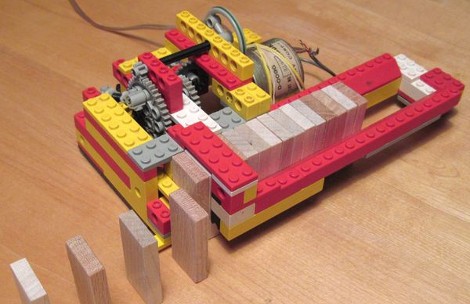[Mattias] brings the awesome once more with his LEGO robot that sets up dominoes. You’ll remember his work from the wooden keyboard case and the mechanical binary adder. This time around he’s still exercising those woodworking skills by making his own domino tiles, but it’s the robot that makes this interesting. In the must-see video after the break the device lays perfectly straight, perfectly spaced dominoes just begging to be upset by a spoiled toddler. The robot is nothing more than handful of LEGO parts powered by a tape deck motor. The parts may be meager, but there’s an abundance of ingenuity tied up in the design.
lego339 Articles
Spreading Christmas Cheer W/ Auto Parts
![newsMainImage[1]](http://hackaday.com/files/2009/12/newsmainimage1.jpeg)
The folks over at [Soup], a British marketing agency, thought up this cool project. It’s a set of handbells hooked up to an Arduino, actuated by central locking motors found in car doors. By the look of some pictures, there was also a Lego version. Songs written by users (through the online interface) are placed in the que of a server. Once it’s time for the song to be played, serproxy sends the Arduino an appropriate set of commands for ringing the bells in sequence. All of this happens in the [Soup] office while it is streaming live through a webcam.
We think that this is definitely a great way to use surplus auto parts. After all, not everyone can build helicopters.
It seems as though the bells are down for the moment, or the employees got a bit annoyed at hearing them constantly ring.
LEGO Book Scanner

Here’s a good one from a few years back. [Muranushi] built a scanner to automatically scan an entire book. LEGO is used as the primary building material. A book is placed on a LEGO balance (inset photo) with a counterweight that eases the work of raising and lower the book. The book is lowered, a LEGO carriage moves across the book to turn the page, the book is raised to the glass of an upside-down scanner and scanned into a laptop.
It seems LEGO and imaging devices are a great match. Most of the parts used here are from LEGO Technical set 8485, a set that comes with motors and a motor controller seen above, on the floor behind the computer. We’ve embedded some video after the break of a book in the midst of the scanning process. Continue reading “LEGO Book Scanner”
BrickAVR: The Proto-brick

Sometimes, prototyping systems need to be robust, full-featured, and powerful. Other times, nostalgia and simplicity are much more appealing. Rather than buying a pre-made prototyping board, one of our readers grabbed some parts lying around, including an Atmega8, a SMD 16Mhz oscillator, and a 6 pin ISP header, and performed some circuit origami free-form soldering (thanks [Gilberti]!). After it was assembled, he realized that it fit in a hollowed out 2×6 Lego brick rather easily. After adding female headers to the pins, as well as a label and some hot glue to seal it up, he was left with a fully functional, and most likely very durable centerpiece to a project. We would love to see this worked into a Lego Mindstorm robot, just for the sake of fitting in.
NXT Turing Machine
[youtube=http://www.youtube.com/watch?v=cYw2ewoO6c4]
This interesting use of Lego popped up on the mailing list of the University of Bergen. Build by a group of Norwegian Danish students, it’s a simple computer that implements Alan Turing’s design from 1937. Having both read and write functions, it implements its own (somewhat inefficient) medium of non-volatile memory. What we find interesting is that rather than move the ‘tape’ through the machine, the machine rolls over the tape. Thanks to [Thorsten] for the tip.
Roundup: Simple Hacks

Here’s a collection of simple hacks you can do in between larger projects. After the break we’ll look at converting an iPod from hard drive storage to Compact Flash, build an LED desk lamp using LEGO and USB power for charging, and use an Arduino shield to add network control at the touch of a button.
Broken TV Brought To Life In LEGO Body

After letting it sit around for about 3 years, [Blake] decided it was time to fix his broken 15″ television. A little trouble shooting showed the problem was with the inverter. The backlight would come on for a few seconds, off for a few seconds, then repeat. By freeing the Magnavox 15MF400T from its metal case he got it working again, but couldn’t find the source of the short. His solution: build a new case out of non-conductive material. Voilà! We have the 15″ LEGO monitor.
It’s not a very complicated LEGO build, but it’s the first case mod we’ve seen in a long time that isn’t strictly gratuitous. Join us after the break for more pictures. Continue reading “Broken TV Brought To Life In LEGO Body”











